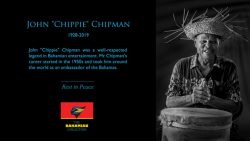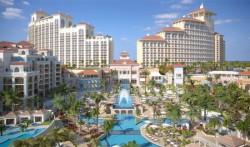In the midst of what appears to be a sustained letter writing campaign to maintain attention on the Bimini Bay development of investor Gerado Capo, a government official is insisting that the proper environmental monitoring is being undertaken.
What started out years ago as initial community anxieties about mass environmental devastation in North Bimini as a result of the dredging for the project, has been refuelled somewhat in recent weeks.
It was sparked by international environmental advocates who have been urging the government to halt the development because of fears that Bimini cannot sustain it, concerns about the fate of treasured mangroves and ultimately the potential adverse effect on marine life.
But Tourism Minister Obie Wilchcombe and the Member of Parliament for West End and Bimini moved to give assurances on Tuesday that all of the concerns raised in the past are being addressed, as was communicated to community leaders over the summer in a meeting with Prime Minister Perry Christie.
モWe are continuously paying attention to what the concerns are,メ he told the Bahama Journal.
モMr Capo has been working with us and is trying to answer all of the questions and deal with the concerns and the fact of the matter is that a lot of this should have been addressed from day one when the land was quieted from 1998 when we werenᄡt the government.メ
Earlier this year, when the government signed a revised heads of agreement with Mr. Capo, Mr. Christie branded the project as economically viable and environmentally sustainable.
Phase I of the plan, in which the development company RAV Bahamas Ltd., plans to pump $70 million, is now under construction.
It calls for a 410 room luxury hotel to include a small casino, 1,080 condos and 440 single family homes. There will also be an 18 hole Links golf course and a marina designed to accommodate 150 pleasure vessels.
Originally, the agreement had provided for 930 rooms, 3, 200 condos and 611 single family homes.
But what still concerns environmentalists, including those who are involved in the international advocate group the Mangrove Action Project [MAP] and the Bahamas Reef Environment and Educational Foundation [BREEF] is the long term effects.
In a letter addressed to the prime minister, MAP pointed out that worst of all the golf course will be built on what is now a mangrove wetland adjacent to North Sound which will be dredged and the sea bottom destroyed.
モThe surrounding land will be sacrificed and filled,メ the letter said. モIn short this development is a disaster waiting to happen. Please take steps now to halt the further loss to this important and beautiful place.メ
The warm clear waters of Bimini flow from the Gulf Stream up onto the Great Bahama Bank. These waters have made Bimini a world famous destination for Big Game Fishing, Scuba Diving, and Shark Research.
In recent days, some Bimini residents have told the Journal that they fear the damage that the development has already caused to Bimini is irreparable.
Bimini resident Frank Hinsey is awaiting a promised visit from the prime minister, although according to government officials a date for that on site inspection of the development has not been set. But an official delegation had travelled to Bimini in the past under the Christie administration.
Mr. Hinsey appeared to be losing hope that the critics who had waged opposition to the project in the past were as concerned as they were originally because they might have been fighting a losing battle.
The dredging for the golf course and marina in phase I of the project could have already adversely affecting fish, shrimp and lobster spawning sites, not to mention the mangroves and wetlands, some believe.
Mr. Hinseyᄡs colleague Jerome Stuart is also fervently hoping for the prime ministerial visit.
In the meantime, their nagging worries persist.
It was the same story from Dr. Samuel Gruber who heads the Bimini Biological Field Station, so much so that in a comprehensive study of the impact of the Bimini Bay development, published in the Bahamas Journal of Scienceᄡs May 2002 edition, he was critical of the reckless excavation of the seafloor without using protective booms, silt barriers or sedimentation traps.
He reported that it had caused extensive siltation throughout the lagoon and nearby coral reefs, ruining the unspoilt habitats.
Although those were conclusions he reached years ago, Dr. Gruber told the Journal recently he was still worried about the projectᄡs impact on the environment of Bimini.
Tameka Lundy, The Bahama Journal



